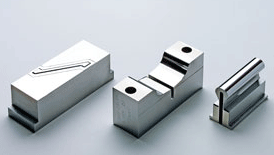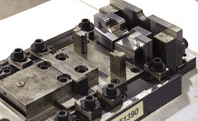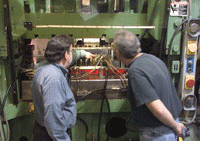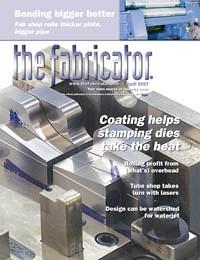- FMA
- The Fabricator
- FABTECH
- Canadian Metalworking
Categories
- Additive Manufacturing
- Aluminum Welding
- Arc Welding
- Assembly and Joining
- Automation and Robotics
- Bending and Forming
- Consumables
- Cutting and Weld Prep
- Electric Vehicles
- En Español
- Finishing
- Hydroforming
- Laser Cutting
- Laser Welding
- Machining
- Manufacturing Software
- Materials Handling
- Metals/Materials
- Oxyfuel Cutting
- Plasma Cutting
- Power Tools
- Punching and Other Holemaking
- Roll Forming
- Safety
- Sawing
- Shearing
- Shop Management
- Testing and Measuring
- Tube and Pipe Fabrication
- Tube and Pipe Production
- Waterjet Cutting
Industry Directory
Webcasts
Podcasts
FAB 40
Advertise
Subscribe
Account Login
Search
Tooling coating extends die life, reduces die rework
Stamper's tooling stands up to aluminum
- April 10, 2007
- Article
- Bending and Forming

Die sections with a narrow slot, such as the one shown on the right, can be coated with Phygen's low-temperature PVD process without fear of warping the tool. According to Ron Saling, tooling supervisor, Glacier Vandervell Bearings, attempts to coat this part with a high-temperature, thermal diffusion coating resulted in having to scrap as many as half of the sections because of warping.
What does the word automobile mean to you? If you are a typical consumer, it likely means styling, horsepower, features, and little else. You probably never look beyond the flashy exterior, which hides numerous fasteners, bearings, bushings, and washers that keep the car together and the moving parts running smoothly. These small components, like the companies that manufacture them, are easy to overlook, yet have a significant role.
For many people in manufacturing, the word has a completely different meaning. For many, automobile means career, and for those who are passionate about their work, a fulfilling one. Two such people are Jim Pasquale and Ron Saling, who work for Glacier Vandervell Bearings, a division of Mahle Engine Components USA, located in Caldwell, Ohio. Pasquale, who has been in manufacturing for 48 years, is supervisor of tools and design services. Saling, who will complete 35 years at the plant in October, is tooling supervisor. They have a direct influence on the company's tooling. Keeping the tooling in good shape keeps the company turning out good parts.
"At the Bearings plant, we make parts for automotive engines and transmissions," explained Pasquale. "At this particular plant, we manufacture what are commonly called bushings and thrust washers. Other plants in our division make rod and main bearings, and items such as piston rings. In addition to the Caldwell plant, we have manufacturing operations in Iowa, as well as Muskegon and St. Johns, Mich. In addition, there are plants located in England, Scotland, Italy, and Slovakia."
Getting the Lead Out
According to Pasquale, the primary product at Caldwell is the bearing material used to make the bushings and washers they ship to their customers.
"We start with 1008 or 1010 steel," he said. "It's our standard basic stock that comes in coil form. We cast any number of different bearing alloys on one side of the steel strip. A lot of the materials correspond to the standard SAE numbers—the standard copper-lead-tin alloys for bearing material. We cast a number of versions of these. We also have sintered versions. We have aluminum, tin, and lead-tin, about 40 different alloys altogether," Pasquale said.
"One of the words that keeps coming up when we talk about bearing materials is lead," Pasquale said. "There's a lot of evidence that lead is a carcinogenic material. Nobody likes lead in the workplace, so we have lead-free materials now. One of the reasons we are seeing so much aluminum being used is that those alloys are lead-free. Tin coatings are basically lead-free as well. We make solid bronzes. We make all steel parts, and all types of materials that you would expect to encounter in the bearing industry—friction or frictionless material as the case may be."
By their very nature, most of these materials have a high lubricity surface, but they do wear tools out quickly.
"Aluminum is really tough on tools," Pasquale explained. "The process of putting aluminum on the steel back transforms the steel into a real metallurgical nightmare. It's hard. It's discolored. It has a lot of nonforming characteristics, and we have to overcome those when we form it."
Seeking a Better Tool Coating
"When it comes to our pressworking operations," Pasquale said, "our basic intention is to reduce setup time and increase uptime. When a job is in the press, I like to keep it in the press, and not have to pull it out to dress tools halfway through the run. When we're in the middle of a run and we have to pull the die out, that's not productive time. So we try to do things to maximize our uptime and reduce our setup time, which results in productivity increases, and that's what we're after."
Over the years Pasquale tried a number of different coating materials and processes in an effort to extend tooling life and boost press uptime. Early coatings, such as titanium nitride (TiN), worked on cutting tools but weren't very useful for protecting forming tools from the extreme pressure and the abrasive materials encountered during forming. Until 2002 he used a thermal diffusion coating with some success, but it had some limitations.

Glacier recently began assigning part numbers to elements of its quick-change tooling. The shinier sections to the right are polished and coated with Phygen's FortiPhy— CrN coating.
"One of the reasons we were looking for something else was that we were having a problem with another process," Pasquale explained. "With that application process, the tools had to be heated to about 1,800 or 1,900 degrees F, and many of our tools were warping. These were the diffusion coatings, and what the coater was doing essentially was re-heat-treating the part. Some of our tooling has a narrow slot cut into it and it always warped at the higher application temperatures of thermal diffusion coatings. When the tools warped, we had no choice but to throw them away. There just was no way to salvage them once they warped."
The company discovered a different coating, one applied at lower temperatures, and decided to give it a try. After consulting with a representative from Phygen Inc., Pasquale and Saling had some of the tooling coated with the company's FortiPhy™ chromium nitride (CrN) coating. Its process delivers a uniform, nanocrystalline microstructure for toughness and uses low temperatures to prevent warping and help keep critical part dimensions within tolerance.
"With our type of tooling geometry," Saling added, "we found that this process solved the problem. We simply have not run into any warping with this process. The first thing we do is take the die steel (mostly A2 or D2), square it up, and cut it to the blank size we need. Then we heat-treat it. We heat-treat it first because if we don't, we run the risk of warping the tool. After heat treating, we run it through the wire EDM process and cut the final shape. Then we send it out for coating."
Many of the materials formed at Caldwell are extremely abrasive. "Especially aluminum," said Pasquale. "It will wear through an uncoated piece of tooling making grooves and gouges, and it destroys the surface. The Phygen coating has prolonged the life of our tooling immensely. On some jobs we get three times the life. On others, eight times. On some, 10 times. It just depends on the particular application and the abrasiveness of our material. Also, the formability of our product in a coated die is much better due to the highly polished surface and the lubricity of the coated surface. This results in a quality product."
Put the Horse Before the Cart
"We won't coat anything on a new die until we first try the die," Pasquale said. "There's no sense in spending the money to coat it and polish it and then get to the press and find that we have to open up a dimension two or three thousandths. In that case, we'd be grinding the new coating off and it does no good. We send a new die to the press and we allow a development period. Some of our people assist in that development—the designer, the press operator, the toolroom people—and we will come up with a tool that we feel will make the part after development. Then we make spare tools for that job, and send those out for coating."
Some things are a given, however. "We always coat the groovers," Pasquale said. "Nobody wants to make a groover 10 times a year when they can make it just one time per year. So that's a cut-and-dried decision, but we don't coat it the first time because the part may be all right in the flat stage, but when it's wrapped up into a bushing, we may have to change the shape or the depth of the groove. So we don't coat anything until we're reasonably sure it is going to work."
Feedback comes directly from the pressroom.
"The press operator is actually my customer," Saling said. "When it comes to how good something is or how long something lasts, the operators let me know."
"This is the best information," Pasquale agreed, "when the operator tells us that what we did solved his problem. I don't know what better testimonial there could be."
Glacier Vandervell Bearings, 17226 CR 57, Caldwell, OH 43724, 740-732-2311
Related Companies
subscribe now

The Fabricator is North America's leading magazine for the metal forming and fabricating industry. The magazine delivers the news, technical articles, and case histories that enable fabricators to do their jobs more efficiently. The Fabricator has served the industry since 1970.
start your free subscription- Stay connected from anywhere

Easily access valuable industry resources now with full access to the digital edition of The Fabricator.

Easily access valuable industry resources now with full access to the digital edition of The Welder.

Easily access valuable industry resources now with full access to the digital edition of The Tube and Pipe Journal.
- Podcasting
- Podcast:
- The Fabricator Podcast
- Published:
- 04/16/2024
- Running Time:
- 63:29
In this episode of The Fabricator Podcast, Caleb Chamberlain, co-founder and CEO of OSH Cut, discusses his company’s...
- Trending Articles
How to set a press brake backgauge manually

Capturing, recording equipment inspection data for FMEA

Tips for creating sheet metal tubes with perforations

Are two heads better than one in fiber laser cutting?

Hypertherm Associates implements Rapyuta Robotics AMRs in warehouse

- Industry Events
16th Annual Safety Conference
- April 30 - May 1, 2024
- Elgin,
Pipe and Tube Conference
- May 21 - 22, 2024
- Omaha, NE
World-Class Roll Forming Workshop
- June 5 - 6, 2024
- Louisville, KY
Advanced Laser Application Workshop
- June 25 - 27, 2024
- Novi, MI



























